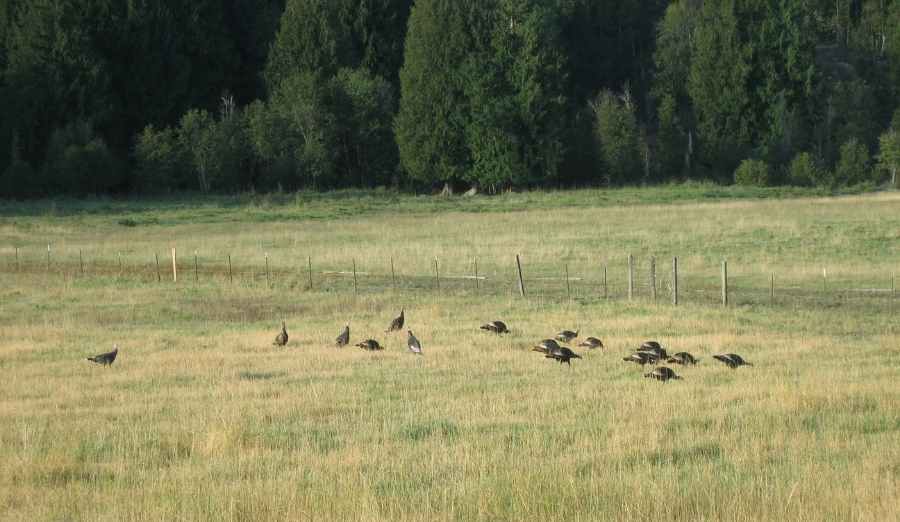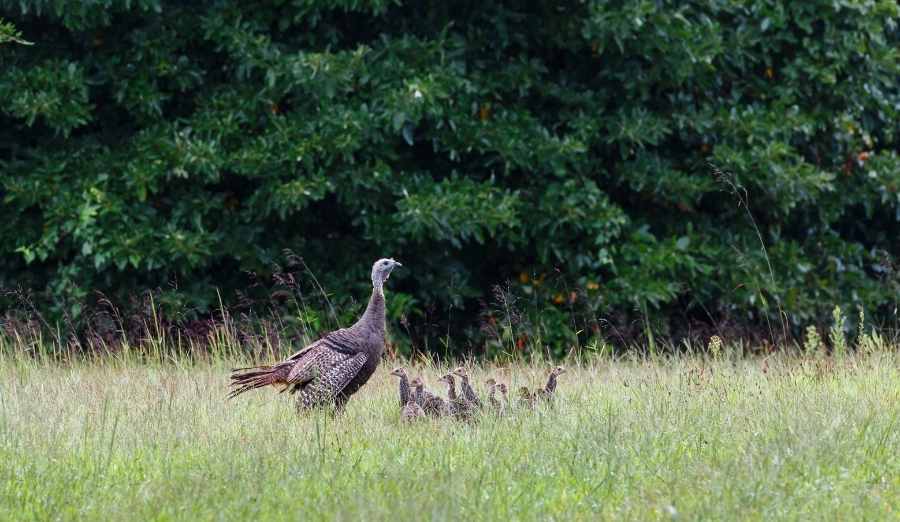Turkeys are hunted in 49 States and three Canadian Provinces. But do you know what a group of turkeys is called? You probably have heard the terms “gang,” “rafter,” or “flock” when referring to a group of turkeys. But what is the correct term? Well, that depends on if you are talking about domestic turkeys or their wild relatives.
Among the diverse bird species that grace the American landscape, few evoke the same sense of grandeur and national pride as the wild turkey (Meleagris gallopavo).
From their captivating mating rituals to their impressive social dynamics, turkeys have carved a unique place in both nature and human culture.
In this exploration, we delve into the world of turkeys, examining their mating season, social behavior, protective measures, and their significance as the national bird of the United States.
Contents (Jump to Topic)
ToggleWild Turkeys – What are Those Groups Called? A Rafter or A Flock
A Flock of Turkeys
A flock represents a group of birds traveling together. And it does not matter if it’s flying birds or not. So yes, I a group of wild turkeys is called a flock – or turkey flocks.
Turkeys roost in flocks. Male Turkeys form all-male flocks outside of the breeding season. The mothers and their chicks travel in a family group – sometimes forming even larger flocks with other family groups.
A global breeding population of 7.8 million turkeys is estimated. About 89% of those living in North America.
But flock isn’t just for birds. Just think about a flock of sheep, a flock of goats, …
When is a Group of Turkeys called a Gang of Turkeys?

I believe that this term is not 100% correct. It sounds more like something my daughter would come up with.
On the other hand: I mean, look at a group of young male turkeys (jakes) – they sure look and behave like a gang, right?
What is a Baby Turkey called?
A young turkey less than four weeks old is called a poult. It only takes them 24 hours to get out of the nest and start pecking at food – mimicking their mother.
“According to the National Wild Turkey Federation, hens lay between 10-12 eggs during a two-week period, but only 10 to 40 percent of turkey nests hatch successfully.“
Source: https://www.nwtf.org/
What Are Male Turkeys called? Or What is a Jake?
The name Jake is used for a male turkey that is at least one year of age and up to two years of age. The name jake was first used by hunters in the 1930s and is slang for turkey hunting.
Most commonly defined as a one-year-old, immature male bird. Young turkeys are called Jakes.
What is a Gobbler?
An adult turkey(at least 2 years old). Also called Tom. According to merriam-webster.com the first known North American use of gobbler was circa 1725.
Incorrect Words That are Used for a Group of Turkey
- Gooble
- Gaggle
Gooble is a loud and gurgling sound made by male turkeys. Gaggle is a term used for a group of geese. Geese make “gagging” sounds, therefore the name.
What Is The Gobble?
The gobble is one of the most common sounds heard during hunting season. It is used primarily by males to let hens (female turkeys) know they are nearby. Gobbling can attract other male turkeys to your position or scare off less aggressive birds. Often, it is used late in the evening when trying to get a tom to gobble.
If you are into turkey hunting, you probably have used a turkey call imitating the gobble sound.
What is a Long Beard?
Usually, a long beard is an older turkey, a tom. Older and larger long beards are more aggressive than younger, smaller birds. It´s a different story when the jakes team up…
A Tom Turkey beard can be up to 10 inches or more. Whereas jakes have shorter beards (most of the time) of “only” 2-3 inches in length.
read.. “where to shoot a turkey”
A Group of Wild Turkeys can be called
- a rafter (domesticated turkey)
- a flock (wild turkeys)
- a gang of turkeys
- a mob of turkeys
A Rafter is A Group of Domesticated Turkeys
A group of domestic turkeys is called a rafter. The first person who formally coined this term was James Lipton in his book ” An Exaltation of Larks. “
Lipton was the first to call a group of turkeys a “rafter.” He derived most of his archaic terms from the Book of Hawking and Hunting (printed in England in 1486).
The Free Dictionary by Farlex (click here) refers to a flock of turkeys as a rafter. However, they do not clarify if this term can be used synonymously with “flock.”
How Many Turkeys are in a Rafter, a gaggle, and a flock?
Technically it only needs to be more than one animal! You probably wouldn´t call two turkeys a rafter – but I think it´s an appropriate term once we´re talking about 11 or more animals in a group …
Happy to hear your thoughts on this! Let me know in the comments
Where do Turkeys Sleep?
The majority of turkeys sleep in large groups called “flocks.” These flocks may contain hundreds of turkeys. Some turkeys prefer sleeping alone, while others prefer being near their “friends.”
At night, wild turkeys usually roost in trees. During the evening, they fly into the trees for protection and then return to the ground during the morning. You can see them scratching the ground and foraging for food in the daytime.
Mating Season
Every year, turkeys experience a distinct period called the mating season, during which they engage in elaborate courtship displays.
Adult males, known as toms or gobblers, exhibit an array of captivating behaviors to attract the attention of the females, or hens.
This includes puffing up their chest, displaying their vibrant tail feathers in a stunning fan-like formation, and emitting resonating gobbling calls that reverberate through the woods.
Such mesmerizing displays serve to establish dominance, attract mates, and ensure the survival of their genetic legacy.
Social Behavior or “Strength in Numbers”
Turkeys are inherently social birds, frequently congregating in groups for various reasons. During the winter months, they form gendered flocks, with adult males often separating from juvenile males and forming their own groups.
This grouping offers several benefits, such as increased protection from predators, efficient foraging, and improved social communication.
These social gatherings, known as rafts, are characterized by a collective vigilance that enhances the overall safety and well-being of the flock.
Protection from Predators or “Safety in the Canopy”
When it comes to evading predators, turkeys employ ingenious strategies. As ground-dwelling birds, they seek shelter in trees, utilizing their strong wings to fly to higher perches when threatened.
By roosting on tree branches during the night, turkeys find safety beyond the reach of many predators, safeguarding their well-being.
This adaptive behavior reflects their instinctual inclination for self-preservation and their ability to navigate their natural environment.
The National Bird
A Symbol of American Heritage – In the United States, the wild turkey has been designated as the national bird since 1782. This recognition underscores its cultural significance and historical connection to the nation’s heritage.
Depicted on currency, featured in folklore, and revered during the Thanksgiving holiday, the turkey embodies the spirit of resilience, adaptability, and communal strength.
Its status as a national symbol serves as a reminder of the country’s rich natural diversity and the intrinsic value of its wildlife.
Turkeys are Galliformes
Galliformes are an order of heavy-bodied ground-feeding birds. Considerable size, robust bodies, and a round fan-shaped tail typify them. Galliformes include chickens, quail, partridges, pheasants, turkeys, grouse, and relatives.
“The order contains about 290 species, inhabiting every continent except Antarctica, and divided into five families: Phasianidae (including chicken, quail, partridges, pheasants, turkeys, peafowl (peacocks) and grouse), Odontophoridae (New World quail), Numididae (guinea fowl), Cracidae (including chachalacas and curassows), and Megapodiidae (incubator birds like malleefowl and brush-turkeys). They adapt to most environments except for innermost deserts and perpetual ice.”
“The name galliformes derives from “gallus”, Latin for “rooster”. Common names are gamefowl or gamebirds, landfowl, gallinaceous birds, or galliforms. Galliforms and waterfowl (order Anseriformes) are collectively called for”
SOURCE: Galliformes. (2022, December 4). In Wikipedia. https://en.wikipedia.org/wiki/Galliformes
7 Fun Facts About Turkeys
- Turkeys have excellent daytime vision and can see in color.
- It is not uncommon to hear a turkey gobble from a mile away! Males also emit a low-pitched drumming sound, moving air in the air sac in their chest.
- A Tom has fleshy wattles covering its face. When excited, it can turn several colors depending on its mood, such as white, blue, pink, and red.
- Males are polygamous, mating as many hens as possible.
- Turkeys are omnivorous! (Beware!)
- Within 24 hours of hatching, baby turkeys, or poults, are on the move with the hen. They grow up quickly, dry off, fluff up, and soon leave the nest.
- Thanksgiving has more turkey consumed than both Christmas and Easter combined. The average person consumes 18 pounds of turkey a year.
Before you go …
Turkeys, with their gendered flocks, vibrant mating rituals, and protective behaviors, captivate our imagination and draw us closer to the marvels of the natural world.
Whether observing a rafter of turkeys foraging in the underbrush or marveling at the magnificence of a tom’s courtship display.
These American birds offer us glimpses into their interconnected lives and inspire a deeper appreciation for the wonders of the avian realm.
As we continue to explore and protect the habitats that sustain them, turkeys will forever remain an emblem of the wild and a testament to the intricate beauty of nature.









